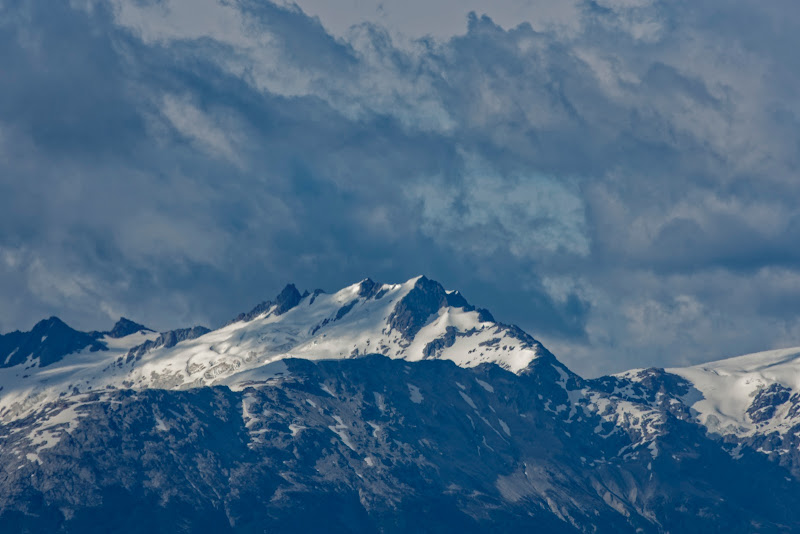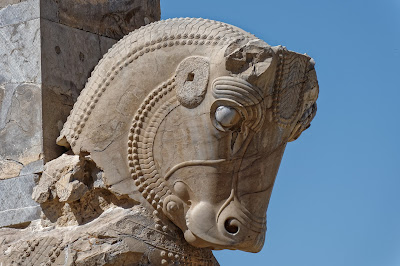Capillas de Marmol, Parque Patagonia, Cochrane, and Caleta Tortel
Dec. 24th 2022 - Capillas de Marmol - Puerto Rio Tranquilo
Arrived in Puerto Rio Tranquilo at 11, found a camp site, did shop for the holidays, washed clothes, and organized a tour by boat to the Capillas de Marmol for the afternoon. 2,5hours to different sights around the lake. Puerto Río Tranquilo's main attraction is the network of marble surreal Salvador Dali-esque caves formed by the glacial waters of Lago General Carrera. These caves are supported by frozen-in-time lava-like columns and on a sunny day, the light reflects off the walls creating ripple patterns in myriad shades of turquoise.
Dec. 26th 2022 - Lagos
From Puerto Rio Tranquilo along Lago General Carrera to the confluence with Lago Bertrand. Lunch break at an inlet of LB and the night in Puerto Bertrand, famous for fishing and watersport.
General Carrera Lake
General Carrera Lake (also known as Lake Buenos Aires) is a glacial lake located in Patagonia and shared by Argentina and Chile. It has a sunny microclimate and is inhabited by a few settlements, such as Puerto Guadal, Fachinal, Mallín Grande, Puerto Murta, Puerto Río Tranquilo, Puerto Sánchez, Puerto Ingeniero Ibáñez and Chile Chico in Chile, and Los Antiguos and Perito Moreno in Argentina. The lake is known for trout and salmon fishing and is connected to the Pacific Ocean via the Baker River.
The General Carrera-Bertrand Suspension Bridge is a popular fly-fishing spot and camping site spanning the confluence of Lago General Carrera and Lago Bertrand. It is an orange bridge that offers stunning views.
Puerto Bertrand
Puerto Bertrand is a small village located at the southern end of Lago Bertrand with the Cordon Contreras mountains as its backdrop. It is the origin of the Río Baker, Chile's largest river in terms of volume of water. The village is famous for trout fishing, horseriding, rafting, trekking, and kayaking. The Río Baker narrowly escaped becoming Chile’s largest hydro-electric project due to fierce resistance from the local community.
Puerto Bertrand was formed in the 1940s when two families of original settlers, the Sansana and Esparza families, donated part of their land to the Río Baker Estancia (now known as Valle Chacabuco) so they could access the water for loading their sheep. The settlers lived off livestock farming and forestry and were employed by Lucas Bridges, an Englishman born in Ushuaia, Argentina.
In the 1980s, Puerto Bertrand made several important advances. This included the formation of a village council, the construction of a health center, and the addition of running water and electricity. The Carretera Austral also reached the village in 1986, connecting it with Chile Chico. The Foundation for the Development of Aysén provided assistance to the locals in terms of education, business management, and technical training.
Dec. 26th 2022 - Valle Chacabuco - Parque Patagonia
A short but tough detour of 12km to see some wildlife in Parque Patagonia, e.g. guanacos, foxes, puma and more.
Parque Patagonia
Valle Chacabuco, a 200,000 acre area between Reserva Nacional Jeinemeni and Reserva Nacional Tamango, is in the process of being merged with the two national reserves to form Parque Patagonia. This new park will span 2,400km2 from Cochrane to Chile Chico, making it one of the most popular tourist destinations in Patagonia.
Valle Chacabuco has been used by Tehuelches for centuries, and in 1906 William Norris accessed it from Argentina. In 1908, the Compañia Explotadora del Baker leased the land to set up a sheep farm, but due to overgrazing and debt, the lease expired in 1964 and was not renewed. The land was appropriated by the government and given to local families, and in 1967 Jeinemeni and Tamango national reserves were formed.
In 1980, Pinochet claimed Valle Chacabuco from families and sold it to a Belgian landowner for $0.5 million. The over-grazing caused the value of wool to drop, making large-scale sheep farming unviable. The estancia was sold to CP the foundation established by Kris Tompkins, in 2004 for $10 million.
CP bought up unviable estancias in Valle Chacabuco and restored the land to its original fertile nature by removing fences and livestock. Native species, such as huemules, were allowed to roam freely, and pumas, previously hunted illegally, were monitored to ensure they did not endanger the huemules. It was discovered that dogs from Cochrane posed a greater threat than the pumas.
Pumas were initially seen as enemies by local ranchers, but evidence from a tagging project showed their population was stable. CP sought a solution to stop puma attacks on sheep, and began breeding guard dogs (Great Pyrenées) that integrated with the herd and successfully protected it from predators. Puma kills have declined since then.
Dec. 28th 2022 - Cochrane
Capitán Prat is a province in Aysén, Chile with three communes: Cochrane (the provincial capital), O'Higgins and Tortel. It covers 37,242km2 and has a population of roughly 4,000 people. The capital, Cochrane, is a small town with a plaza, shops, restaurants, a petrol station and the last ATM before Argentina for those travelling south.
Thomas Cochrane
After a career in the Royal Navy, Cochrane was elected to the House of Commons in 1806 and was later expelled due to his criticisms. He then moved to Chile and joined their fight for independence, becoming Vice Admiral and taking charge of the Chilean navy. Thomas Cochrane fought for the independence of Brazil and Greece in 1823 and 1827 respectively. After his father's death in 1831, he returned to the British navy and was later knighted by Queen Victoria in 1847. He died in 1860 and is buried in Westminster Abbey, with a wreath-laying ceremony held annually by the Chilean navy in May. In 2006, the Chilean navy acquired a Type 23 frigate from the British navy and named it Almirante Cochrane.
Dec. 29th 2022 - Animal Farm
Dona Orfelina has opened a little camp ground on the way to Caleta Tortel on her farm. Gravel roads now everyday, with many hills and lot of them steep, but the changing landscape, the lakes, the surrounding mountains, and the (mostly) friendly people make up for the tough riding.
Dec. 30th 2022 - Caleta Tortel
Caleta Tortel
Caleta Tortel is a magical place and a gateway to the northern and southern icefields, but due to its lack of petrol station, ATM, or decent shops nearby, it can be expensive for budget-conscious travelers. Boat trips to the glaciers also require fuel from Cochrane, making them costly. Despite this, Caleta Tortel is still worth visiting for its interesting legends.
Tortel, a commune in Capitán Prat province, has two populations (Caleta Tortel and Puerto Yungay) with a total population of 500. The region is surrounded by protected areas such as the Parque Nacional O'Higgins, Parque Nacional Laguna San Rafael and Reserva Nacional Katalalixar, and covers an area of 21,000km2.
Caleta Tortel is an architectural marvel built almost entirely on boardwalks at the base of a mountain. Houses are situated up the side of the mountain and connected by steep stairs. Every house has a view over the bay, and there are no cars or horses. Visitors can park their car or bicycle at the upper part of the village, and descend the stairs to the main village. There is also a water taxi service available upon request.
History
The region was first inhabited by the Kawesqar, an indigenous nomadic canoeist group. Hernando de Magallanes was the first European to discover the area in 1520. Interest in the Río Baker Estuary led to various expeditions in the late 19th century, including the famous German explorer Hans Steffen in 1898. In 1901, the Chilean government awarded a concession to Juan Tornero to populate the region with 1,000 families, which led to the formation of the Compañia Explotadora del Baker and eventually the mysterious death of 70 Chilote workers. The graves of some of these workers can be seen on the Island of the Dead, a major tourist attraction in Caleta Tortel.
Timber exploitation in the region was popular until the early 1940s when a series of fires made it uninhabitable. In 1955, the Chilean Armada established an outpost and development continued slowly until 1981 when the village was founded with 300 inhabitants. Since then, it has had many developments like a landing strip, a municipal building and school, boardwalks, drinking water, sewage works, a small hydro-electric plant, a library, and various piers for boats. In 1999, work began on the 23 km road connection to the Carretera Austral, completed in 2003.
Dec. 31th 2022 - Rain and some pain
Well the pain was that within 30min and shortly before the 12 o'clock ferry I had two punctures in my back tire, and realized that not only the tube but the tire was affected. Made it at 11.58 to the ferry pushing my bike and met on the other side three cyclists who could help me out with a pump, because I brought a tube with sclaverand but a pump for car valves. Separated again until I had my second tube fixed but after 25km I catched up with them and I knew a place along the road wit a new shelter, safe from rain but not the cold wind, it was a chilly night in my bivouac, no place for two tents in the sheltered area.





















































































